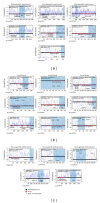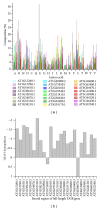Uses of phage display in agriculture: sequence analysis and comparative modeling of late embryogenesis abundant client proteins suggest protein-nucleic acid binding functionality
- PMID: 23956788
- PMCID: PMC3727180
- DOI: 10.1155/2013/470390
Uses of phage display in agriculture: sequence analysis and comparative modeling of late embryogenesis abundant client proteins suggest protein-nucleic acid binding functionality
Abstract
A group of intrinsically disordered, hydrophilic proteins-Late Embryogenesis Abundant (LEA) proteins-has been linked to survival in plants and animals in periods of stress, putatively through safeguarding enzymatic function and prevention of aggregation in times of dehydration/heat. Yet despite decades of effort, the molecular-level mechanisms defining this protective function remain unknown. A recent effort to understand LEA functionality began with the unique application of phage display, wherein phage display and biopanning over recombinant Seed Maturation Protein homologs from Arabidopsis thaliana and Glycine max were used to retrieve client proteins at two different temperatures, with one intended to represent heat stress. From this previous study, we identified 21 client proteins for which clones were recovered, sometimes repeatedly. Here, we use sequence analysis and homology modeling of the client proteins to ascertain common sequence and structural properties that may contribute to binding affinity with the protective LEA protein. Our methods uncover what appears to be a predilection for protein-nucleic acid interactions among LEA client proteins, which is suggestive of subcellular residence. The results from this initial computational study will guide future efforts to uncover the protein protective mechanisms during heat stress, potentially leading to phage-display-directed evolution of synthetic LEA molecules.
Figures





Similar articles
-
Identification of Late Embryogenesis Abundant (LEA) protein putative interactors using phage display.Int J Mol Sci. 2012;13(6):6582-6603. doi: 10.3390/ijms13066582. Epub 2012 May 29. Int J Mol Sci. 2012. PMID: 22837651 Free PMC article.
-
Dehydrin Client Proteins Identified Using Phage Display Affinity Selected Libraries Processed With Paired-End Phage Sequencing.Mol Cell Proteomics. 2024 Dec;23(12):100867. doi: 10.1016/j.mcpro.2024.100867. Epub 2024 Oct 21. Mol Cell Proteomics. 2024. PMID: 39442694 Free PMC article.
-
The effect of phosphorylation on the salt-tolerance-related functions of the soybean protein PM18, a member of the group-3 LEA protein family.Biochim Biophys Acta Proteins Proteom. 2017 Nov;1865(11 Pt A):1291-1303. doi: 10.1016/j.bbapap.2017.08.020. Epub 2017 Sep 1. Biochim Biophys Acta Proteins Proteom. 2017. PMID: 28867216
-
Plant Group II LEA Proteins: Intrinsically Disordered Structure for Multiple Functions in Response to Environmental Stresses.Biomolecules. 2021 Nov 9;11(11):1662. doi: 10.3390/biom11111662. Biomolecules. 2021. PMID: 34827660 Free PMC article. Review.
-
Uses of phage display in agriculture: a review of food-related protein-protein interactions discovered by biopanning over diverse baits.Comput Math Methods Med. 2013;2013:653759. doi: 10.1155/2013/653759. Epub 2013 Apr 28. Comput Math Methods Med. 2013. PMID: 23710253 Free PMC article. Review.
Cited by
-
Functional in vitro diversity of an intrinsically disordered plant protein during freeze-thawing is encoded by its structural plasticity.Protein Sci. 2024 May;33(5):e4989. doi: 10.1002/pro.4989. Protein Sci. 2024. PMID: 38659213 Free PMC article.
-
Late Embryogenesis Abundant Protein-Client Protein Interactions.Plants (Basel). 2020 Jun 29;9(7):814. doi: 10.3390/plants9070814. Plants (Basel). 2020. PMID: 32610443 Free PMC article. Review.
-
Dissecting the cryoprotection mechanisms for dehydrins.Front Plant Sci. 2014 Oct 29;5:583. doi: 10.3389/fpls.2014.00583. eCollection 2014. Front Plant Sci. 2014. PMID: 25400649 Free PMC article.
-
Exploring the fate of mRNA in aging seeds: protection, destruction, or slow decay?J Exp Bot. 2018 Aug 14;69(18):4309-4321. doi: 10.1093/jxb/ery215. J Exp Bot. 2018. PMID: 29897472 Free PMC article.
References
-
- Clegg JS. Cryptobiosis—a peculiar state of biological organization. Comparative Biochemistry and Physiology. 2001;128(4):613–624. - PubMed
-
- Crowe JH, Carpenter JF, Crowe LM. The role of vitrification in anhydrobiosis. Annual Review of Physiology. 1998;60:73–103. - PubMed
-
- Sun WQ, Leopold AC. Cytoplasmic vitrification and survival of anhydrobiotic organisms. Comparative Biochemistry and Physiology A. 1997;117(3):327–333.
Publication types
MeSH terms
Substances
LinkOut - more resources
Full Text Sources
Other Literature Sources
Molecular Biology Databases

